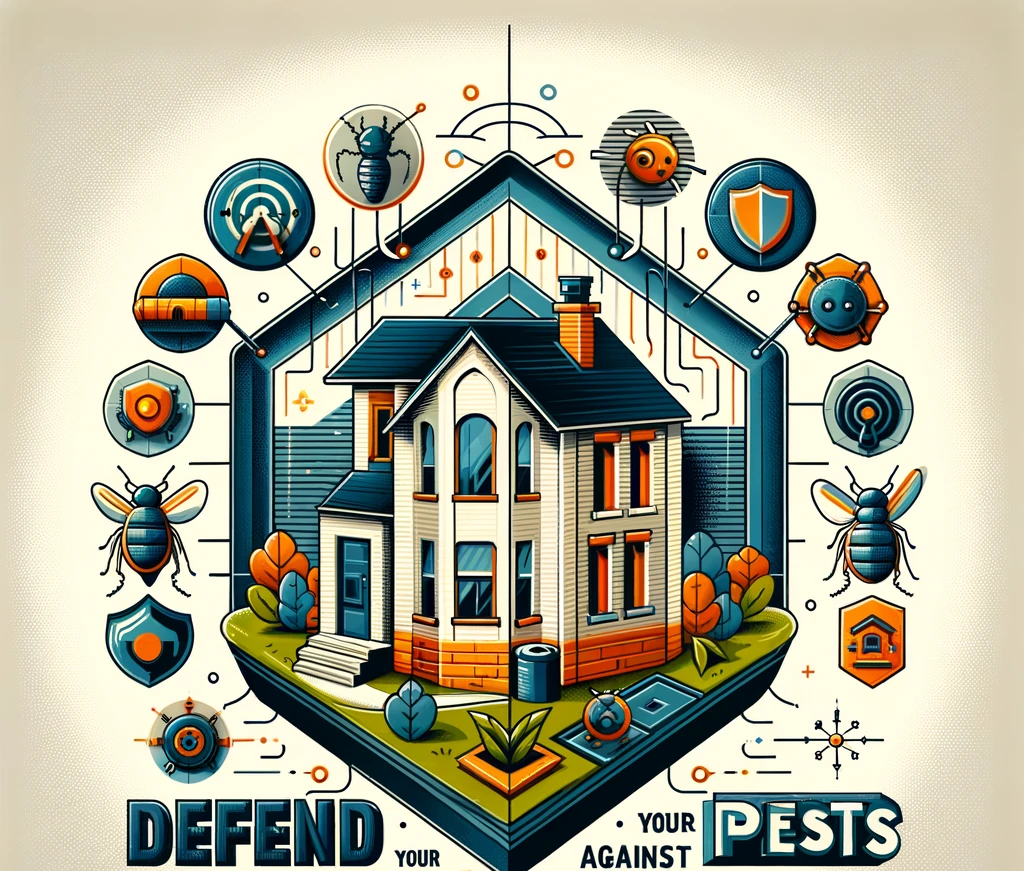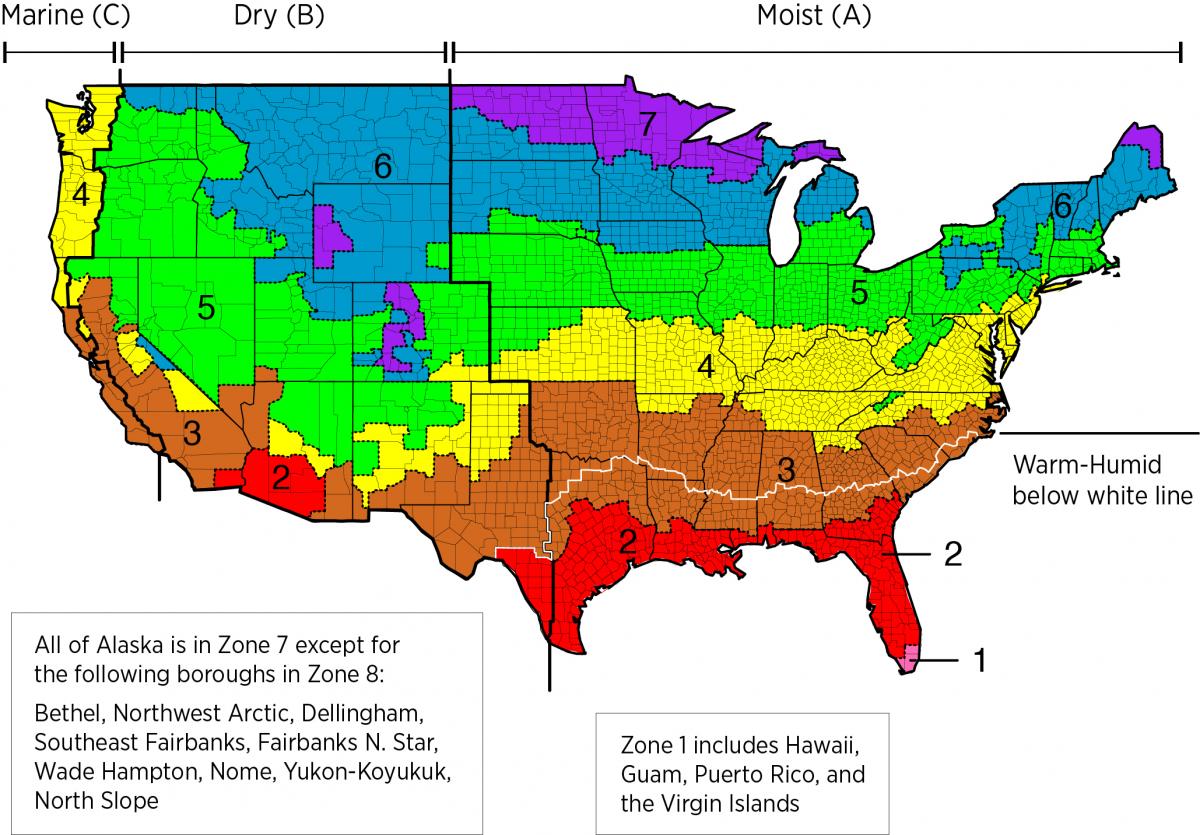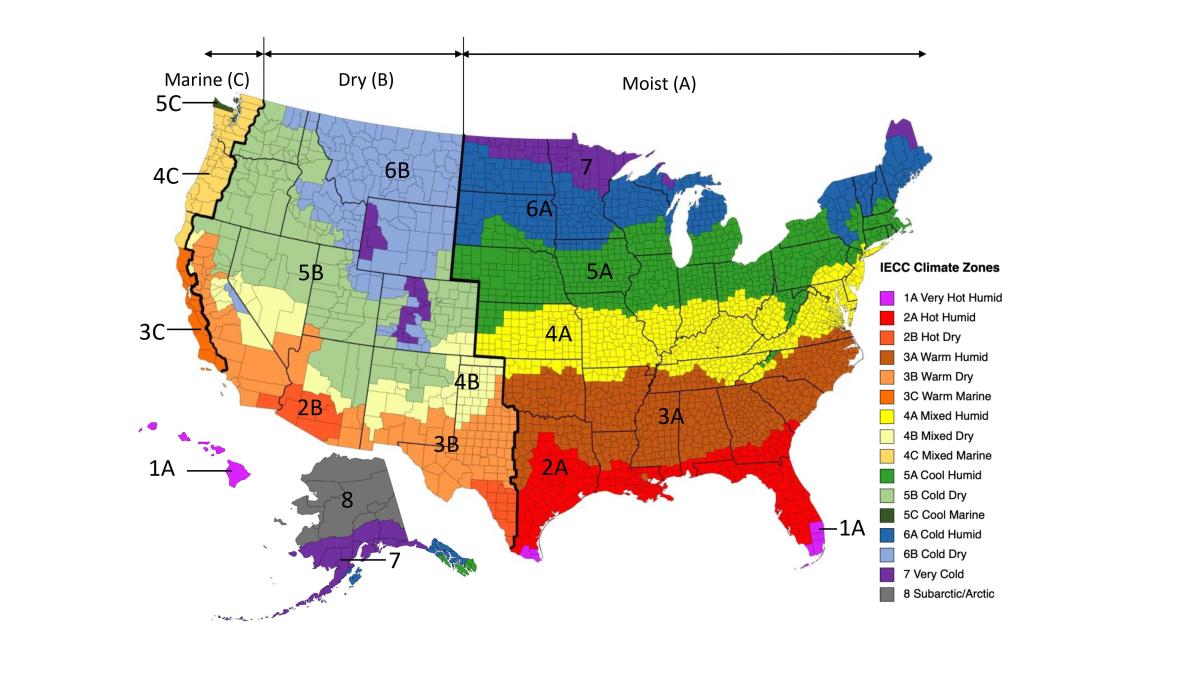When constructing homes, take steps to minimize food, water, harborage, and entry for pests.
- Seal Foundation Penetrations:
- Seal all penetrations in the foundation wall and at joints between the foundation and exterior above-grade walls.
- Seal all cracks around plumbing and wiring penetrations and cover with metal flashing.
- Termite Precautions:
- In moderate to heavy termite areas, use solid concrete or filled concrete block at the top of foundation walls.
- Reinforce concrete slabs and walls to minimize cracking.
- Use treated wood or metal sill plates.
- Water Management:
- Minimize standing water and damp wood around the foundation.
- Remove woody debris around the structure after construction.
- Avoid planting within 2 feet of the home.
- Direct irrigation away from the home.
- Use gutters and employ water management practices.
- Mesh and Screening:
- Employ durable mesh and screening at all vents.
- Use bug screens on all openable windows.
- Install flashing around doors and windows.
- Use weather stripping and tight-fitting door sweeps.
Pests like insects and rodents can carry diseases, damage structures, and create health hazards. To reduce pest intrusion without relying solely on chemicals, builders can take several measures during construction.
- All animals need food, water, and shelter. Builders can take an integrated pest management approach to deny access to these essentials.
- Even small openings can allow pests to enter, so sealing gaps and air sealing the building envelope are crucial.
- Managing water and moisture effectively also makes a home less inviting to pests.
Table 1. Maximum Gap Sizes for Excluding Various Pests (Source: Geiger and Cox 2012).
| Common Name | Scientific name | Maximum opening size/mesh size | Reference |
|---|---|---|---|
| Insects/Arthropods | |||
| Biting midges | Ceratopogonidae | 0.605 mm ~30 mesh | AFPMB, 2009 |
| Cheese skipper | Piophila casei | 0.595 mm ~32 mesh | Ebeling, 1975* |
| Cockroaches | Blatella germanica | 1.66 mm ~12 mesh | Koehler, 1994** |
| Cotton aphid | Aphis gossypii | 0.341 mm ~50 mesh | Bethke & Paine, 1991* |
| Fruit flies | Drosophilida spp. | 2.12 mm ~10 mesh | NPS, 2006 |
| Honeybees | Apis spp. | 3.00 mm ~7 mesh | NPS, 2006 |
| House flies | Musca domestica | 2.03 mm ~10 mesh | Block, 1946 |
| Mosquito | Aedes egyptii | 1.03 mm ~18 mesh | Wesley & Morrill, 1956; Block, 1946 |
| Mosquito | Anopheles quadrimaculatus, Culex quinquefasciatus | 1.38 mm ~14 mesh | Block, 1946 |
| Redlegged ham beetle | Necrobia rufipes | 0.595 mm ~32 mesh | Ebeling, 1975* |
| Sand flies | Phlebotomus spp. | 0.423 mm ~40 mesh | AFPMB, 2009 |
| Spiders | Various | 0.595 mm ~32 mesh | Ebeling, 1975* |
| Stable fly | Stomoxys calcitrans | 1.12 mm ~16 mesh | Koehler, 1994** |
| Yellowjackets | Vespula spp. | 3.97 mm ~4 mesh | CIE, 2007 |
| Vertebrates | |||
| Bat | Tadarida brasiliensis | 6 mm ~¼ inch | Wilkins & Lewis, 1999; FMC, 2000 |
| Bird, House sparrow | Passer domesticus | 19 mm ~¾ inch | Wilkins & Lewis, 1999 |
| Bird, Starling | Sturnus vulgaris | 45 mm ~1¾ inch | Wilkins & Lewis, 1999 |
| Lizard, Green | Anolis carolinensis | 11 mm ~7/16 inch | Wilkins & Lewis, 1999 |
| Rat, Black | Rattus rattus | 13 mm ~½ inch | Bantlin, 2002** |
| Rat, Brown | Rattus norvegicus | 13 mm ~½ inch | Bantlin, 2002** |
| Rat, Norway | Rattus norvegicus | 19 mm ~¾ inch | Wilkins & Lewis, 1999; Bantlin, 2002** |
| Squirrel, Eastern Gray | Sciurus carolinensis | 19 mm ~¾ inch | Wilkins & Lewis, 1999 |
| Squirrel, Fox | Sciurus niger | 32 mm ~1¼ inch | Wilkins & Lewis, 1999 |
| Squirrel, Southern Flying | Glaucomys volans | 19 mm ~¾ inch | Wilkins & Lewis, 1999 |
| Squirrel, Western Gray | Sciurus griseus | 32 mm ~1¼ inch | Wilkins & Lewis, 1999 |
| Snake, Black Racer | Coluber constrictor | 6 mm ~¼ inch | Wilkins & Lewis, 1999 |
| Snake, Garter | Thamnophis spp. | 6 mm ~¼ inch | Wilkins & Lewis, 1999 |
| Snake, Rattlesnake | Crotalus spp. | 13 mm ~½ inch | Wilkins & Lewis, 1999 |
| Snake, Western Coral | Micruroides euryxanthus | 6 mm ~¼ inch | Wilkins & Lewis, 1999 |
| Snake, Western Diamondback | Crotalus atrox | 13 mm ~½ inch | Wilkins & Lewis, 1999 |
| Snake, Western Lyresnake | Trimorphodon biscutatus | 13 mm ~½ inch | Wilkins & Lewis, 1999 |
Reduce Pest Entry Outside
Roof:
- Design roofs with simple geometries.
- Install metal drip edge.
- Use leaf guards over gutters.
- Fit curved roof tiles with metal bird stops.
- Install metal flashing at roof-wall junctures and valleys.
- Use pest-resistant vents.
- Secure soffit vents.
- Install chimney covers.
Exterior Walls:
- Use pest-resistant wall materials.
- Use termite-resistant siding materials.
- Use rodent-resistant materials.
- Install borate-treated insulation.
- Caulk or seal gaps.
- Provide clearance between siding and soil.
- Seal holes and joints.
- Install screening behind cladding.
Exterior Doors and Windows:
- Use metal or solid-core doors.
- Fit doors with metal kick plates in rodent-prone areas.
- Ensure tight-fitting doors and use door sweeps.
- Install screen doors and weather-stripping.
- Install screens on windows.
- Use head, side, and sill pan flashing.
Exterior Attached Structures:
- Use termite-resistant materials for decks and fences.
- Install screening around decks.
- Prevent rodents from climbing downspouts and pipes.
- Use exterior lighting with motion detectors.
- Provide outdoor storage.
Landscaping:
- Avoid planting trees or shrubs near the home’s walls.
- Maintain clearance between walls and tree limbs or branches.
- Provide distance between shrubs and buildings.
- Avoid planting near the home.
- Use drip irrigation.
- Avoid certain plants that attract pests.
- Minimize wood chips and mulch near the foundation.
Minimize Moisture:
- Slope patios, walks, and driveways away from the building.
- Tamp backfill and slope the grade away from the foundation.
- Install vapor barrier and capillary break.
- Ensure siding clearance from grade.
- Use gutters with downspouts.
- Keep wood debris away from the house.
Discourage Roosting and Nesting Birds and Rodents:
- Screen openings in buildings and likely perches.
- Create defensible space by keeping plants, wood piles, and mulch away from the house.
Retrofit Pest Intrusion
- Inspect the Perimeter of the Existing Home:
- Carefully examine the area around your home.
- Identify any potential access points for pests, including tree branches, gutters, and gaps or cracks in the structure.
- Remove Materials Touching the House:
- Ensure that tree branches, bushes, or any other materials do not touch the exterior of the house.
- Damp wood can attract pests, so it’s important to remove any materials that encourage entry.
- Ensure Proper Drainage:
- To prevent water from pooling around the house, make sure the ground slopes away from the house at a rate of 0.5 inch per foot for 10 feet on all sides.
- Proper drainage helps deter pests and also benefits water management.
- Inspect House Foundations and Crawlspaces:
- Examine the house foundations, including the inside of the crawlspace.
- Refer to the Pre-Retrofit Assessment of Crawlspaces and Basements for guidance on avoiding moisture issues and pest infestations.
- Seal All Holes, Gaps, and Cracks:
- Identify and seal any holes, gaps, or cracks in the structure.
- Common points of entry for rodents and insects include poorly sealed doors and utility penetrations.
- Cover Openings with Pest-Resistant Materials:
- Install rodent-resistant door sweeps in areas prone to rodent activity.
- Avoid using blown-foam sealant in areas exposed to the sun or where it’s expected to block pest entry.
- Cover all openings with animal- and weather-resistant screens, one-way doors, self-closing louvers, or other suitable coverings.
- Consult U.S. Department of Energy’s Standard Work Specifications:
- For further information on preventing pest entry and infestation, refer to the U.S. Department of Energy’s Standard Work Specifications.
Sealing Cracks, Gaps, and Holes:
- Ensure that untreated wood does not come into contact with the ground or concrete foundations.
- Cover exposed earth in crawlspaces and basements with a 6-mil polyethylene vapor retarder, overlapping joints by 6 inches and sealing them.
- Seal all holes, gaps, and cracks, especially around doors, pipes, and utility penetrations. Small gaps can be filled with foam, spackle, or caulking, while larger gaps may require reinforcement.
- Cover holes with wood or metal plates or use wire mesh and a hardening compound to seal them on both interior and exterior surfaces.
- Pay attention to sealing the junctions between walls and floors, as well as between walls and ceilings.
- Seal light switch boxes, outlet boxes, and other cracks and penetrations with gaskets and caulk.
Rodent-Resistant Door Sweeps:
- Install rodent-resistant door sweeps in areas prone to rodent entry.
- Ensure that the sweep provides full coverage to prevent rodents from squeezing through gaps at the bottom or corners of doors.
- Use metal and rubber door sweeps that extend the entire length of the door and touch the ground without holding the door open.
Cellulose Insulation with Boric Acid:
- Consider using blown-in cellulose insulation treated with boric acid as both a fire retarder and insecticide.
- This treated insulation can be used in various components of existing homes, including exterior walls, vented attics, overhangs, and floors over garages.
Covering Holes and Other Access Points:
- Fill all holes, gaps, and cracks with durable, chew-resistant materials.
- Ensure that permanent openings like windows, vents, and flues are covered with grates or screens made of durable materials.
- Consider materials like galvanized sheet metal, galvanized hardware cloth, stainless steel, vinyl-coated hardware cloth, or vinyl-coated welded wire mesh for durability.
- Pay attention to openings under decks, porches, and cantilevers, and install fences or barriers to prevent access by animals.
- Chimneys should have covers that meet fire codes to keep out raccoons, squirrels, bats, and birds.
Windows and Vent Covers:
- Install screens on all operable windows and passive ventilation openings to minimize the entry of flying insects.
- Filters can also be added to HVAC air intake ports to block insect entry.
- Ensure that vents are covered with durable materials to prevent pest access.
- Properly secure metal louvered grates over soffit vent openings.
- Replace plastic gable louvers with metal gable louvers, and ensure that gaps between slats are narrow enough to prevent nesting.
- Pay attention to clothes dryer vents and choose designs that exclude pests without causing lint buildup.
- Inspect crawlspace vents and cover them with ¼-inch metal screens.
Sewer Vent Pipes and Chimneys:
- Cover sewer vent pipes with commercial shields to prevent rodent and bird entry.
- Install chimney covers that meet fire codes to keep out raccoons, squirrels, bats, birds, and other animals.
- Check sweep chimneys and ensure that caps are secure.
Open Areas Under Decks, Porches, and Cantilevers:
- Consider installing fences or barriers (rat walls) to prevent animals from nesting under decks, porches, or cantilevers.
- Ensure that fences have a bottom edge or “shelf” to deter digging under them.
- One-way doors can be used in rat walls to allow animals to exit before permanent closure.
Compliance Guidelines
ENERGY STAR Single-Family New Homes (Version 3/3.1 – Rev. 11):
- Air Sealing: According to the National Rater Field Checklist, ducts, flues, shafts, plumbing, piping, wiring, exhaust fans, and other penetrations to unconditioned space should be sealed. This is in accordance with section 4.1 of the checklist.
- Above-Grade Sill Plates: Ensure that above-grade sill plates adjacent to conditioned space are sealed to the foundation or sub-floor. If they are resting atop concrete or masonry, a gasket should also be placed beneath them. This requirement is outlined in section 4.3 of the checklist.
- Exemptions: Existing sill plates on the interior side of structural masonry or monolithic walls are exempt from the above requirements, as stated in Footnote 27 of the checklist.
- Alternative Cladding System: In Climate Zones 1 through 3, a continuous stucco cladding system adjacent to sill and bottom plates is permitted to be used in lieu of sealing plates to the foundation or sub-floor with caulk, foam, or equivalent material. This is detailed in Footnote 28 of the checklist.
DOE Zero Energy Ready Home (Revision 07):
- Certification Requirements: Under Exhibit 1 of DOE Zero Energy Ready Home, Item 1 requires certification under the ENERGY STAR Qualified Homes Program or the ENERGY STAR Multifamily New Construction Program.
- Indoor airPLUS Certification: Item 6 of Exhibit 1 mandates certification under EPA Indoor airPLUS.
EPA Indoor airPLUS (Revision 04):
- Pest Entry Minimization: Seal all penetrations and joints between the foundation and exterior wall assemblies, as required by section 3.1.
- Sump Covers: Air seal all sump covers, also specified in section 3.1.
- Additional Precautions: The code recommends additional precautions in areas with termite infestation probability, including specific construction details for foundation walls, slabs, and sill plates.
- Rodent/Bird Screens: Provide corrosion-proof rodent/bird screens for all building openings that cannot be fully sealed and caulked. Clothes dryer vents are exempt from this requirement.
2009 International Energy Conservation Code (IECC):
- Slab-Edge Insulation: Section R402.2.8 notes that slab-edge insulation is not required in jurisdictions designated as having a very heavy termite infestation.
- Air Leakage: Section R402.4 specifies that the home should be constructed to limit air leakage, with specific areas to be caulked, gasketed, or sealed. Air leakage testing requirements are also mentioned.
2012, 2015, 2018, and 2021 IRC:
- Slab-Edge Insulation: Similar to IECC, these codes specify that slab-edge insulation is not required in areas with a very heavy termite infestation.
- Air Leakage: The codes require constructing the home to limit air leakage and conducting blower door tests, with specific requirements based on climate zones.
- Retrofit: Retrofit requirements for existing buildings are provided, including the need for additions, alterations, renovations, or repairs to conform to the provisions of the code.
2009, 2012, 2015, 2018, and 2021 International Residential Code (IRC):
- Termite Control: Sections R318.1 – R318.3 describe control methods for termite prevention, including field-applied chemical treatments and barriers.
- Foam Insulation Restrictions: These codes restrict the installation of foam plastic insulation in areas with termite infestation probability and provide exceptions for specific conditions.
- Retrofit: Retrofit guidelines for existing buildings are included, with requirements and exceptions outlined.
By following these steps, homeowners can reduce the risk of pest intrusion in their homes during construction.
For immediate service or consultation, you may contact us at Allied Emergency Services, INC.
Contact Information:
- Phone: 1-800-792-0212
- Email: Info@AlliedEmergencyServices.com
- Location: Serving Illinois, Wisconsin, and Indiana with a focus on the greater Chicago area.
If you require immediate assistance or have specific questions, our human support is readily available to help you.
Disclaimer: This article is intended for informational purposes only. For professional advice, consult experts in the field.










